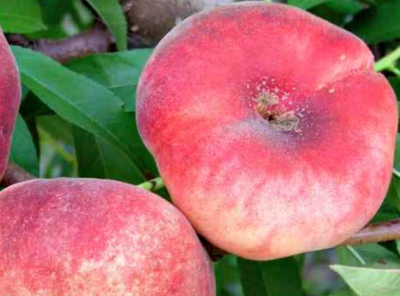
- Growth type: medium-sized
- Appointment: for fresh consumption
- Winter hardiness: high
- Fruit weight, g: 90-120
- Abdominal suture: deep
- Fruit color: greenish-cream with blurred dot and streak blush from bright crimson to carmine color
- Skin : of medium thickness, rather firm, cannot be removed from the fetus
- Scent: there is
- Escapes: annual shoots rather thick, red on the lit side and yellowish green on the shady side, with short internodes
- Flowers: pink-shaped, large, with strongly concave corrugated, pale pink petals
Belmondo is one of the best fig peaches. Despite the difficulty in care, many gardeners prefer to grow a crop.
Description of the variety
The tree is medium-sized, with a spreading crown. Shoots have shortened internodes. On the sunny side, the shoots are red, and on the shaded side, they are yellow-green.
Fruit characteristics
The main color of peaches is greenish cream. Almost over the entire surface, the fruits have a blush in the form of grouped dots and strokes from a deep crimson to carmine color. Peach varieties have a unique aroma.
The fibrous juicy pulp of a pale cream color is covered with a rather dense skin of medium thickness, with a slight pubescence. In ripe fruits, the stone is well separated.
Peaches are disc-shaped with a deep abdominal suture, the apex of the fruit is depressed, with a fossa up to 5 mm deep. The fruits are of medium size, their weight ranges from 90 to 120 g.
Taste qualities
Fig peach Belmondo tastes more intense than that of round varieties, since due to the shape of the fruit, the peel is closer to the stone, and this affects the taste. After all, the most delicious pulp of other varieties is located next to the bone, but the fig variety does not have this: a rich taste is felt in any part of the fruit.
The pulp of the peach is highly sugar-rich (about 12.63%), therefore, well-ripened fruits are sweet and spicy, with a honey flavor, almost no acid is felt in them (about 0.18%). According to the tasting assessment, the Belmondo variety deserves 4.6 points.
Ripening and fruiting
Ripening period is defined as medium late. Fruit ripening occurs in the first half of August.
Yield
The yield of mature trees is high. They are densely covered with fruits closely spaced to each other.
Growing regions
The territories of western China, Ukraine, Central Asia, Transcaucasia, eastern regions of Tajikistan, Turkmenistan and other Asian republics are favorable for cultivation of the variety. In Russia, the variety is grown in the southern regions.
Growing and caring
Cultivation involves:
- watering and feeding;
- annual sanitary pruning with crown formation;
- preventive measures to combat pests and diseases;
- protection of young seedlings from freezing.
It is required to feed the plant already at planting. Further feeding is applied from the second year. Spring dressing consists of mineral and organic nitrogen fertilizers, and autumn dressing consists of potassium-phosphorus mixtures. Before winter, the trunk circle should be insulated with manure, without touching the trunk.
Fan pruning should provide maximum access to the sun's rays to the fruit. The optimal length of the branches is no more than 50 cm. The cuts are treated with garden pitch.
Spraying with 1% copper sulfate will save you from wintering spores and mycelium. Spraying is required 4 times: after the snow melts, when buds appear, before and after flowering.



Frost resistance and the need for shelter
This variety has high winter hardiness. Late flowering gives flower buds the freedom to suffer from the spring frost. However, it is better to insulate young seedlings, especially during snowless winters. You can use agrofiber for this.

Requirements for soil and climatic conditions
Chernozem and loam are the best soil for this variety. It is best to plant a peach seedling on the south side of the garden, where there is a lot of sun and no wind. Neighboring trees or buildings should not be shadowed by the peach.
In warm climates, seedlings are planted in autumn, and in colder regions in spring.

Review overview
They note the high yield of the variety, an excellent dessert taste reminiscent of the taste of mango. It is important that correctly removed fruits do not crack and tolerate transportation well.































































